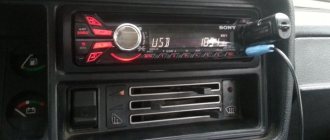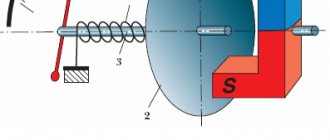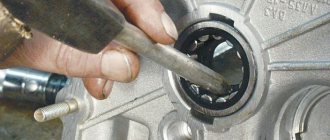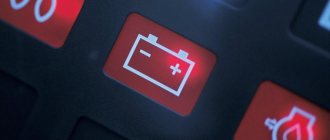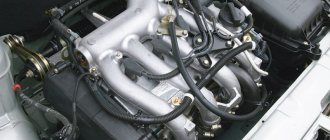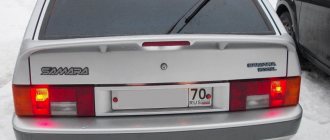The presence of play in the steering mechanism is normal practice, and even the traffic rules provide for the operation of cars with such defects. The allowed play on passenger cars is 10 degrees, and even with this level you will feel that the steering wheel is trying to tilt to the side. If the play is even greater, operation of the machine is prohibited and the problem must be corrected. The above lists defects that the driver can fix on his own or at one of the nearest service centers. In this case, more serious problems are possible - bending of the steering rack, problems with rods, rollers and other elements of the steering mechanism. If none of the tips listed above helped to fix the problem, you need to contact a service center specialized in a particular brand of car to carry out a thorough diagnosis and repair.
Steering wheel pulls when braking
Separately, it should be noted that there is a malfunction due to which the steering wheel pulls to the left or right when braking. Most often this happens due to jammed brake pads. Diagnosing this malfunction is quite simple. It is necessary to drive the car for about 15-20 kilometers in normal city mode, without straining the brakes too much. When the distance has been covered, you need to get out of the car and spray a little water on the brake disc calipers.
If they turn out to be hot and the liquid boils, you will need to check the serviceability of the pads, discs and drum. Most often in such a situation it is necessary to replace the brake discs.
Why does it pull to the side when braking - Dirty brake pad
Brake pads or linings contaminated with fluid or grease will prevent the brake assembly on that side of the system from operating properly.
- Check the suspected front or rear brake assemblies by raising and supporting the vehicle securely on jack stands.
- Remove the wheel assembly.
- Check the brake pad and rotor (front brakes) or pads and drum surface (rear brakes) for grease, oil, or other foreign matter.
- You may need to look for leaks or contamination.
- Make repairs and replace the pads or caliper if necessary.
Check caliper operation.
Steering wheel pulls when accelerating
When spontaneous movement of the steering wheel to the right or left is observed only when accelerating, it is recommended to begin troubleshooting from the following points:
- Checking tire pressure;
- Inspect the tires for damage or differences in tire wear on one axle.
High-quality wheel alignment;
In rare situations, the steering wheel pulls to the side during acceleration due to serious problems in the steering mechanisms or play.
Guys, this is the problem with the VAZ 2114. I drove and noticed that the steering wheel was hitting hard and pulling to the left (I started to turn right, somehow turned it with force, after which the car started hitting somewhere in the area of the left wheel, and the sound was as if an aluminum can had been tied (and through for about five minutes she just stopped dead in her tracks. The engine runs smoothly. I put it in gear, release the pedal, and again there’s this sound of an aluminum can being tied, and it doesn’t move ((what is this? has anyone encountered this?. The steering wheel pulls to the right in a VAZ 2114.
Similar articles
"
I had a left drive, erase it, most likely it broke off ())
Why does a car pull to the right when accelerating?
If the car pulls to the right when accelerating, but there are no problems when moving evenly, wheel alignment and crooked wheels can be discounted, since incorrectly aligned wheels always pull to the side. When the car pulls to the right when accelerating, you need to look at:
Clear signs of problems with the steering mechanism.
- steering;
- suspension and chassis;
- transmission.
Most often, when you press the gas, the car pulls to the right precisely because of a faulty steering mechanism. A slightly less common problem occurs when the wheel bearing wears out, which prevents the wheel from rotating freely and slows it down. A worn drive CV joint acts in a similar way. Very rarely, the culprit may be a differential, which, due to a breakdown, unevenly distributes torque between the wheels of one axle. The main reasons why the car pulls to the right when accelerating are presented in the table below.
| Why does it drag | Causes | How does it manifest itself? | What do we have to do |
| Play in the steering | Wear of the power steering (power steering) | The car pulls strongly to the right when accelerating, sometimes it hits the steering wheel, and when you press the gas, the steering wheel begins to play. The car “walks” on a flat surface, taxiing becomes less responsive. When turning the steering wheel in place, knocking noises from the steering rack may occur. | Complete diagnostics of the steering - from the rack and power steering to the steering knuckles. Replacing faulty parts with new ones |
| Steering rack wear | |||
| Worn tie rods and/or ends | |||
| Suspension faulty | Wear of silent blocks | The car pulls to the right when accelerating, and creaks in the suspension are possible, stability at speed decreases, and the car becomes more “loose” to control. The jacked wheel has play in the longitudinal direction (left-right) | Replace worn parts with new ones, adjust wheel alignment |
| Production of stabilizer bushings | |||
| Play in ball joints | |||
| Wear of springs and shock absorbers | When accelerating on a straight line, the car tilts to one side and begins to pull to the right. | Replace suspension springs/shock absorbers | |
| Changing the axis angle | The car pulls to the right when accelerating in any speed mode (whether slowly or quickly), turning in one direction is noticeably easier than in the other (best noticeable on a car without power steering/power steering) | Check the integrity and geometry of suspension parts and chassis. Compare caster (axle angle) of the drive wheels and wheelbase on the left and right, adjust if necessary | |
| Wheel bearing jams | When accelerating, the car pulls to the right, but the camber is normal. The hub, brake and wheel rims on the right get hot | Replace wheel bearings | |
| Transmission problems | Front-wheel drive design feature | The car pulls a little to the right during acceleration with working suspension, steering and other mechanisms | On a car with a transverse internal combustion engine (front-wheel drive and all-wheel drive), a slight shift towards the longer (usually right) axle shaft is natural |
| CV joint wear | When the steering wheel is level, the car pulls to the right; during maneuvers with a large turn (parking, turning, etc.), the CV joint may crunch | Replace worn CV joints | |
| Differential fault | The car pulls to the right at speed or when decelerating; when jacking up one drive wheel, it is difficult to turn; noise is possible in the differential area | Repair differential |
On vehicles with a transverse engine and front-wheel drive, a slight sideways movement during acceleration is not a malfunction. Since the gearbox of such cars is shifted to the side (usually to the left), the drive shafts to the wheels have different lengths. During the spin-up process, the torque on them, due to centrifugal forces, is not distributed quite evenly, which causes the car to pull towards the longer drive (usually the right one). This problem is most pronounced on powerful engines.
Lada 2114 2003 - breakdown
Cars for sale
Lada 2114 Samara, 2011
Lada 2114 Samara, 2011
Lada 2114 Samara, 2011
Lada 2114 Samara, 2013
Brake problems
Problems with brake mechanisms appear both after pressing the pedal and while driving. The reasons are as follows:
- complete failure of one of the working cylinders, including on the rear axle;
- jamming of the working cylinder piston in various positions;
- fluid leakage from the brake circuit tube;
- failure of the hydraulic valve of the anti-lock braking system.
When the working cylinder on one of the front wheels fails, the car literally rolls away after sharply pressing the brake. If the car pulls to the left, it means the right cylinder is not functioning and vice versa. When the brake cylinder of the rear axle fails, the car does not pull away so clearly. The easiest way to find the “culprit” is by leaking brake fluid, inspecting each hub from an inspection ditch or simply looking under the car.
On cars with high mileage and worn calipers, the piston of the working cylinder may become stuck in the position of squeezing the pads. The wheel on the side of the faulty mechanism is continuously braked, and the car constantly moves in the same direction. It is easy to identify a breakdown: after driving 1–2 km, feel all the wheel rims with your hand. The “culprit” will be revealed by the heated rim.
If the piston of the working cylinder is frozen in a free position, then the vehicle will drift during the braking process - the car will drift in the direction opposite to the non-working mechanism. To finally make sure that the element is broken, hang the wheel from the suspicious side and try to spin it with the brake pedal pressed.
Diagnosing anti-lock braking system (ABS) problems in a garage environment is difficult. If fluid does not pass through one of the valves, you will have to disassemble the calipers and make sure that the cylinders are functioning normally. It’s easier to go to the nearest car service center, where technicians will check the brakes using specialized equipment.
Pulling a car to the side is considered an anomalous phenomenon, which instills fear in most motorists; some are ready to refuse to buy such a car because of this. Why this happens and why everyone is so afraid of cars that are pulled to the side, we will tell you in this article.
Let me start with the fact that ideally, the car should drive straight, even if you let go of the steering wheel. Any pull of the car to the side is considered a malfunction and requires careful study, since such a phenomenon is often a sign of serious problems with the car.
see also
Comments 29
I also found it on the forums.
Why does it pull to the right? Knowledgeable people say that the engine sank. This is noticeable - the left side of the engine (if you look at the car) has gone down a little. This is a misalignment of the rotation axis of the drives. Extra load on the internal CV joints.
People recommend replacing all three supports with new ones.
What do you people think, can this happen?
In general, the same garbage appeared. Coasting - everything is perfect. You press on the gas and it pulls to the right. I thought and thought.
“Difference of drives” is a scam for suckers. In order for efforts to be exerted to twist the drive, you need acceleration like a McLaren in Formula 1
The following applies here:
1. The rubber in the daisy of the left lever was flattened - hence the play appeared. 2. The same thing happened with the tires of the left crab. 3. The daisy nut is loose
Let's ask the question - why exactly the LEFT?
It's simple - I travel mostly alone. The left wheel has more grip on the ground. In general, the load is greater on the left wheel.
3. Since free movement of the left wheel suspension has appeared, the car axle CHANGES ITS POSITION relative to the body - THE LEFT WHEEL WHEN ACCELERATING - MOVES A LITTLE AHEAD.
1. Tighten the daisy nut. 2. Tighten the lever nut near the body
3. Replace the left “crab”
The crabs are changed in pairs; if one crab goes away, the castor will go away and it will be necessary to regulate it.
It won't go away! There is a steel bushing inside the rubber. The rubber ages and wears out due to the longitudinal movement inside the crab cage. When braking and picking up speed, the castor “walks”.
From the factory, I had a pull to the right when accelerating and even in neutral, the tires were hitting the outside. The alignment was ideal, the car was new, I stopped by and did diagnostics, everything was ok. I swapped the wheels and started pulling to the left. all because of the rubber. tires white 100. then I threw the rear wheels on the front. I was driving fine, but the inside part was already damaged. The rack also knocks from the factory. Now either I’ve caught a hole or the camber has somehow miraculously gone wrong, but now the right wheel is even visually turned to the right and the left one is straight. The steering wheel is turned 2-3 degrees, the car pulls heavily. Plus, at 110 km/h the steering wheel probably hits a hole. In general, it should pull a little when accelerating. due to the difference in drive length, weight and diameter.
I went for a year. Nothing was going anywhere at all.
How did you solve this problem?
I have exactly the same problem, in neutral, just when you give it the gas it pulls a little to the right. I installed SS20 shock absorbers for only a year, recently changed the ends with balls, put on new tires, and like a good bastard I went to the wheel alignment. I'm thinking maybe I can play with castor? Because the wreckers are too lazy to regulate it, they say it’s within the normal range and that’s it, but God knows what the norm is for this car) In short, it was too late to go back. After 3 days I got into my garage and spent half an hour climbing with a tape measure, and measured from wheel to wheel, and to the beam, and from what I didn’t measure))) I have a whole body, I’m the only one) and so I measured mm. There are 6 differences between the front chassis, for Vera the crabs I installed new ones, one of the old ones seemed to be a little crooked and the rubber bands were worn out. In general, the difference after replacing the crabs was 2 mm, now there is a shift to the right but barely noticeable, there was no time to set it to ideal, but I’m wondering if 2 mm really plays a role?
Chassis and suspension malfunctions
When mechanical problems occur, the car pulls to the side much more than from the difference in tire pressure or different tread heights. The following faults cause the vehicle to be driven away:
- Worn tie rod ends. The ball pin does not turn well in the hinge, and sometimes it simply jams. A clear sign is that the steering wheel does not return to its original position on its own, the car continues to move in an arc.
- One of the steering rods was bent as a result of the impact and became several millimeters shorter. The toe angle of the front wheels is disrupted, tire wear on the affected side is accelerated, and the car is driven in the appropriate direction.
- The ball joint is stuck. The pin rotates around its own axis with great difficulty and does not allow the wheels to turn freely. At the last stage of wear, the hinge emits a loud creaking sound - a harbinger of final failure.
- The separator of one of the wheel bearings is destroyed. The balls scattered and ground into metal shavings, blocking the rotation of the hub. The car pulls towards the jammed wheel.
- After repairing the suspension, the alignment procedure was performed incorrectly or not done at all.
Advice. Not all reasons for a vehicle's deviation from a straight line are so critical. More prosaic moments also happen, for example, the bolts holding the hub have come loose. Hence the recommendation: before troubleshooting, check the reliability of the threaded connections of the suspension, chassis and steering rods.
How to diagnose these faults in a garage environment:
- Drive the car into an inspection ditch and check the steering rod ball pins. You need to grab the rod with your hand and try to rotate it around its axis. A serviceable hinge will allow it to rotate with little tension, a loose one will allow it to rotate very easily, and a jammed one will not allow it to rotate at all.
- The bent rod is also easy to notice from the inspection hole. The part must be replaced immediately, you can continue driving only after adjusting the camber - toe.
- To check the rotation of the ball joint, it is advisable to hang the front of the car and turn the wheels manually. Option two: diagnose play by alternately rocking the wheels.
- Wear and destruction of the bearing does not occur silently - the phenomenon is accompanied by a hum and grinding noise while the vehicle is moving. To check for damage, hang the wheel from the “noisy” side and spin it by hand. A broken bearing will immediately stop rotating or start grinding.
Messages 7
1 Topic by shirbk 2013-12-16 23:32:20
- shirbk
- New member
- Inactive
- Registration: 2013-12-16
- Messages: 3 Thanks : 0
- Car: VAZ 21103
Topic: Car pulls to the right, camber is normal
Hello. The problem is that the car pulls to the right, so you have to keep the steering wheel turned to the left. The car (21103, 2003, mileage 230,000) was purchased in March, it pulled, but almost not noticeably, so it didn’t bother me. I decided to do the SR, it didn’t help, it remained the same, but since it didn’t pull much, I scored. I drove until I decided to repair the chassis. I changed the struts, supports, levers, silent blocks, caps, calipers, silent blocks of the rear beam, changed the balls maybe a couple of months before (I didn’t change it myself, maybe they changed something else but I forgot). I went to do the alignment (to another office), and again I didn’t like it. But again, I didn’t really decide that the roads were crooked and it really didn’t always pull, sometimes it pulled, sometimes it didn’t, and sometimes it could start to lead a little to the left, but this is rare. I changed my shoes for the winter and after a while I noticed that there were almost no spikes left on the front right wheel along the outer edge. Again I went to the breakdown in another city, the master said that almost everything was normal, turned the nuts and everything on the computer turned green like OK. On the way home, I again couldn’t figure out whether I was pulling or not. A couple of days ago I went on business for 130 km and on the way back (I noticed it was when I was driving from there) I had to hold the steering wheel almost 35-40 degrees to the left in order to go straight, but then as I entered my area (30 kilometers to my house) it became better and the steering wheel began to turn to the left a little as usual and pulls a little. What could this be? The car doesn't seem to be damaged; some friends looked at it; I tried changing the wheels from left to right, but it didn't help on the summer tires (directional in the summer, asymmetrical in the winter), the pressure is normal, the wheel alignment is supposed to be the same, the summer tires haven't been eaten up, the winter tires aren't visible yet. Help me please.
2 Reply from Wolfy36 2013-12-17 08:34:18
- Wolfy36
- New member
- Inactive
- Registration: 2013-12-12
- Messages: 19 Thanks : 5
- Car: VAZ 21120
Re: Car pulls to the right, camber is normal
shirbk — The car doesn’t seem to be broken; friends looked at it outbid
I would “sin” against your friends - by all indications, the body is driven, and not badly driven, take it to a service station and look at the geometry of the body. since it’s unlikely to be anything else, try the “moose” test, drive up to 60 km (on an empty, flat road.) let go of the steering wheel and squeeze the brake, if it pulls to the right - the body is in danger (but in fact everything is clear - once SR normal, but eats rubber)
3 Reply from 2013-12-17 09:40:49
- New member
- Inactive
- Registration: 2013-11-18
- Messages: 23 Thanks : 6
- Auto: 21120
Re: Car pulls to the right, camber is normal
I had this happen because of the tires, and the tires were new. I also suffered with the car pulling to the side, it’s especially annoying on long roads, it’s not a pleasure to drive, but it’s stressful. I also went to a wheel alignment and did it three times in a row. to the poor dismantler until he installed it perfectly. He showed me the second and third time on the monitor that everything was perfect. The tires were changed from the rear to the front, since the guides did not roll in an X-shape. He sinned on the tires, but I stubbornly did not want to believe this. In general, I drove with the car slightly diverted to the side. Winter came, I went to them to change shoes, they took off the summer ones, put them on winter ones, installed the wheels on the car, talked to them about how it drives the same way leading to the side. I left them, drove out of town and strangely the car didn’t pull to the side, everything was perfect, I realized that the problem was in the tires. I sold the tires, the one I took off (the problematic one), winter was over, I got castings from the garage with tires, the front one was bald and eaten away at the edges. Even with such tires, it drove smoothly. As the wrecker told me, this could be due to crooked tires, a small spring, or a blow to the car from the top. I’ve seen driving a broken car to the wrecker , on two cars, and each time the demolition guy told me about the problem and that there was not enough degree for the wheel alignment, he asked me to fix this, this, that. Therefore, I think if your car bit is critical, that after the wheel alignment you are pulled to the side , the wheel alignment specialist could tell you that the car has swerved and it’s not possible to properly set the wheel alignment. I’m sinning on the tires. + Is the rubber (air) still leaking?
4 Reply from shirbk 2013-12-17 11:28:33
- shirbk
- New member
- Inactive
- Registration: 2013-12-16
- Messages: 3 Thanks : 0
- Car: VAZ 21103
Re: Car pulls to the right, camber is normal
Well, regarding the brokenness, I’m still sure that it’s not broken, there’s just nothing to dig into, mastic seams, gaps, no wrinkling of the side members, etc. and I’m 99% sure of outbids. It’s difficult to look at geometry in our city, there are definitely no such services, and if there are private owners, I don’t know about them, but I’ll look for them. But he does NOT eat rubber.
Added: 2013-12-17 12:28:33
As for the tires, I tried them on two sets. Both summer and winter lead, and each has its own tire rims. . The tires are still Continental, not cheap, and they shouldn’t be crooked. I'll try to ask a friend, maybe try some shoes and it will help. I’ll find out more about the springs, maybe from them, because sometimes I notice that the car seems to sag with its face on the right side. Could the steering rack be the cause? Is there a bite there or something like that?
Tire pressure
If your tires are not inflated evenly, this is another possible reason for your vehicle to pull to the side. It is worth checking the pressure in all wheels. If the car leaves a straight course, then the first thing to do is check the pressure in the wheels on the side where the car goes.
If the difference between the tires is at least 0.5 atmospheres, the car will definitely go off course. To eliminate the cause, it is enough to inflate the wheels so that they have the same level.
Why does the car pull to the left or right when you let go of the steering wheel?
It is not uncommon for drivers to encounter the fact that the car does not want to go in a straight line if it is not constantly monitored. If you let go of the steering wheel for a second, the car begins to be pulled to the left or right from the trajectory that was before.
If you are faced with a similar problem, then this article should help you. Here we will look at the main reasons that can lead to such behavior of the car, and also talk about how this can be corrected.
First, let's list the main reasons why a car may pull to the left or right when the driver lets go of the steering wheel.
- tire problems;
- incorrectly installed directional wheels;
- wear of steering tips or breakage of steering rods;
- wheel bearing wear;
- broken wheel alignment;
And so, let's start, as expected, with what you can check and fix with your own hands. Namely, from the tires. To diagnose this problem, you need to swap the wheels. Place the front ones back and the rear ones forward. If the situation has improved, you should put a spare tire on the side in which the car is heading. If the problem goes away, then all that remains is to change one wheel to working tires.
If you have directional wheels, make sure the arrows on them point in the correct direction. If the direction is correct, then it is necessary to check the wheel alignment. Alas, to do this you will have to go to a service station, since a similar procedure is not carried out in a regular garage. Often, it is violations of the correct camber and toe angles that cause the car to become obstinate on the road. In addition, the stability of the car decreases, tire wear increases and other unpleasant phenomena may appear. If everything is in order with this parameter, then the reasons should be looked deeper.
Worn steering tips or broken steering rods can also cause the car to pull to the right or left while driving. In principle, you can check these elements in your own garage, especially if it is equipped with an inspection pit. But if you don’t know how to determine steering system malfunctions for sure, it’s better to contact specialists, especially since you’re also unlikely to be able to replace them yourself. Therefore, contact a professional to diagnose your steering system.
Malfunctions in the hub, especially wear of the wheel bearing, can just as easily cause the car to spontaneously drift away from the correct trajectory. The actual wear of the wheel bearing can be clearly heard by characteristic knocking, crunching and grinding sounds in the area of the wheel on which the wheel bearing has worn out. As a result of such wear, the smooth rotation of the wheel is significantly impaired. Which cannot but affect the trajectory of the car. The wheel bearing should be changed not just in a repair shop, but in a repair shop whose quality of work you completely trust. This is not an easy task and the slightest mistakes can cause very rapid wear of the wheel bearing. Therefore, it should be changed by a truly conscientious and experienced specialist.
When braking, the car pulls to the side - Uneven brake wear
Brake pads and drums should wear gradually and at the same rate on each side, just as brake pads and drums should brake gradually and at the same speed.
But problems with this system can cause this unit on one wheel to wear excessively compared to the unit on the opposite wheel, causing braking force to be distributed unevenly across the wheels.
Inspect both front or rear wheel assemblies for uneven wear. Excessive brake pad or rotor wear on one side may be a sign of problems with the entire system that need to be further investigated.
Test your brakes to find and fix the problem.
If you are dealing with uneven wear on your brake pads, rotors or drums, check:
- stuck caliper piston
- jammed wheel cylinder piston
- Loose or stuck fastening hardware - check the tightness of the bolts on all connections of the brake system of your car
- for proper lubrication of the caliper and pin, see the video below
Refer to your vehicle's repair manual. If you don't already have a manual, you can find one on the Internet or in specialized auto stores.
Check for fluid leaks around the hydraulic lines, exhaust valve and caliper piston.
Other reasons
So we have listed the main reasons that can cause the car to pull to the right or left. But these are only the most common reasons. Meanwhile, although much less frequently, such difficulties can be caused by pads that have not completely moved away from the brake disc. The wheel again wedges slightly and slows down, which causes deviations from the straight line along which the car is moving. In severe cases of traffic accidents, suspension arms and even body elements may become bent. In such situations, it is not surprising that the car pulls to the right or left. And it is extremely difficult to correct anything here.
Well, if a left-hand drive car pulls a little to the right, and a right-hand drive car, respectively, to the left, then this may be a normal setting of the power steering. For safety reasons, car manufacturers provide for the car to smoothly move away from oncoming traffic if you suddenly fall asleep or feel ill. But such a deviation is not clearly expressed, and, moreover, does not appear immediately. Actually, breakdowns of the power steering, and especially the electric power steering, as well as other steering elements, can cause the car to deviate from a straight line when you have poor control of the steering wheel.
Why does the car go off course?
There are several typical faults that can cause the car to pull to the right or to the left.
And the roads, or rather their condition, are not always to blame. The most popular reasons are:
- wheel alignment;
- tire pressure;
- play in the steering;
- condition of the rubber.
Below we will look at everything in more detail.
Steering wheel pulls left or right
There may be several reasons why the steering wheel constantly pulls in one direction or another. We will try to analyze all the typical cases, but first we will note the main typical situations when the steering wheel can move away from the neutral position:
Steering gear play . The permissible play of the steering wheel should be within 5 degrees in both directions. If there is excessive free play, the steering wheel may tilt in one direction or another.
Displacement of the rear wheels (axle) relative to the body axis. Violation of body geometry may cause the steering wheel to pull to the right or left. Plus, the problem may arise due to poor-quality wheel alignment. Experts recommend adjusting the front wheels taking into account the displacement of the rear wheels, then such troubles will not occur.
The rear wheel camber is not calibrated . If there is a sufficiently large difference in the camber angles of the rear wheels, the steering wheel pulls to the left or to the right, depending on the specific situation. This is especially true when there is a negative angle on one wheel and a positive angle on the other.
Uneven tire inflation or tire defects are quite often prerequisites for the steering wheel to move away from neutral. The difference in tire pressure should not exceed 0.5 atmospheres. In some cases, problems associated with rubber defects can be eliminated by changing tire locations or rotating the tires on rims.
Unidentified defects in steering or chassis components. Sometimes hidden design or manufacturing defects are quite difficult to detect during maintenance, during repairs and wheel alignment adjustments.
The steering wheel pulls to the side when the camber is not adjusted
The Macpherson suspension is equipped with struts equipped with oval holes, which allow you to loosen the mounting bolts and rotate the knuckles along with the wheels to a certain angle. At the same time, some models of imported cars may not provide wheel alignment adjustment. This situation is typical for Korean cars Kia and Hyundai, as well as Japanese cars Nissan and Mitsubishi, equipped with a suspension whose struts have round holes. As a result, the appropriate adjustment cannot be made. If the steering wheel pulls to the side, the problem can be corrected by boring the holes to allow the bolts to loosen and the knuckles to turn.
Most often, on cars with right-hand drive, the camber angle is made taking into account the slope of the road built for left-hand traffic. To eliminate steering wheel pull, in this case, you will also have to bore the holes in the struts and adjust the wheel alignment for right-hand traffic, as is customary in our country.
When braking, the steering wheel pulls to the side
If the steering wheel pulls to the side when braking a car, you need to check the serviceability of the brake system.
Usually in these cases, the main reason for the steering wheel slip is due to wear or a defect in the braking cylinder on one side or another of the body or air entering the system.
First try bleeding the brake system. If the problem persists, inspect the brake cylinders. When you press the pedal, the cylinder rods should come out evenly. If this does not happen or the rods do not retract, or there is a fluid leak, you will have to replace the failed brake cylinders.
The second reason for a car to pull to the side during braking can be a significant difference in wheel alignment angles. When the values of the pitch and camber angles are quite different, the car will pull to the side when braking. While during acceleration or when moving uniformly, your car can move in a straight line due to the mutual balancing of these parameters.
When accelerating, the steering wheel moves to the side
If on a car with front-wheel drive there are additional washers (spacers) installed on the front springs, as evidenced by the raised front end, the steering wheel may pull in one direction or another, depending on which side the thicker washer is on. In this case, both axle shafts will work at different angles. Due to the inequality of centrifugal forces, the car may be pulled in one direction or another.
On VAZ cars of the 2108, 2109 and 2110 series, the vehicle is already designed to be pulled to the side. However, this can be eliminated by independently adjusting the angles of the racks. You should remove one or two washers from the right side and move them to the left side. On some foreign cars, to prevent the car from pulling to the side, damping counterweights are provided on the axle shafts.
The steering wheel pulls to the side after performing a maneuver
For some car models (for example, Audi 100 and Moskvich 2141), sideways movement may occur after turning. After turning the steering wheel to the left, it pulls to the left all the way, and when turning to the right, the steering wheel goes to the right. This situation is a consequence of the failure of the upper supports. If they jam, the spring begins to knock on the cup, rather than turning with it, as it should be according to the design of this unit. The problem is solved by identifying the damaged element and then replacing it.
Rear brake adjuster
The rear wheel brake assembly can also fail when the brake adjuster becomes stuck or fails. Brake shoe adjusters must maintain the correct distance between the brake shoe linings and the drum as the linings wear. Most vehicles use a sprocket (screw) type mechanism for the adjuster, while some modern vehicles may use a latch type mechanism for the adjuster.
- Raise and securely support the vehicle on a stand.
- Remove the wheel and drum.
- Check for free movement of the regulator.
- Consult the repair manual for your specific vehicle model to repair or replace the regulator if necessary.
Faulty tire and belt layers can also cause the brakes to stretch.
Pulls when braking
Separately, I would like to consider the situation when the steering wheel begins to pull strongly when braking, pressing the brake pedal.
This mainly happens if the brake pads are stuck. It's not difficult to check. You need to drive about 15 kilometers in quiet city mode without overloading the brakes. Then stop, get out of the car, and pour a small amount of water on the brakes. Approximately in the caliper area. If the brakes are hot and evaporation begins, the cause has been found.
See alsoTrailer for transporting long cargo: which one to choose

